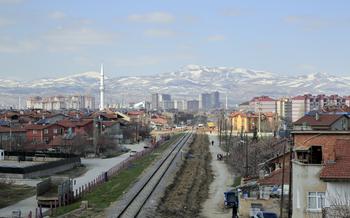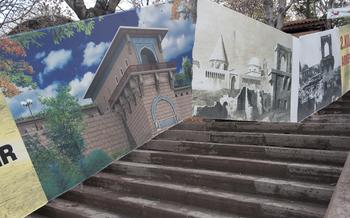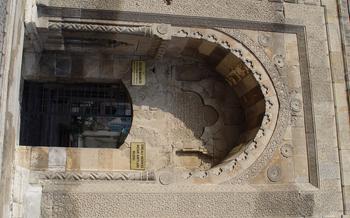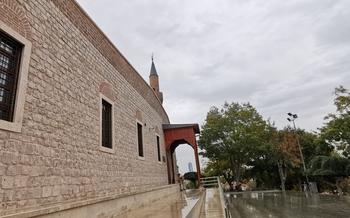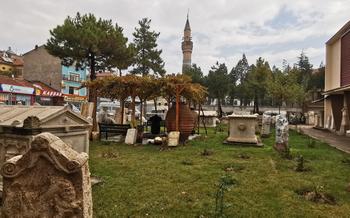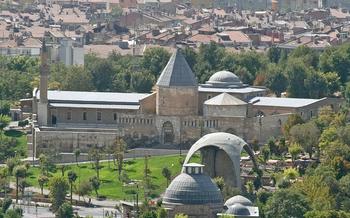
Karatay Medrese
- Historical Significance
- Architectural Marvel
- Museum Exhibits
- Peaceful Atmosphere
- Guided Tours
- Photography Opportunities:
- Location and Accessibility:
- Cultural Significance
- Dress Code and Etiquette:
- Visiting Hours:
- Nearby Attractions
- Local Cuisine
- Souvenirs and Shopping
Historical Significance
In the heart of Konya, nestled amidst the remnants of history, stands the majestic Karatay Medrese, a testament to the grandeur of the Seljuk era. Founded in the 13th century by the illustrious Seljuk Sultan Kayqubad I, this architectural marvel served as a beacon of Islamic learning and education during a time when knowledge was revered and sought after. The medrese's rich history unfolds as you step through its portals, inviting you on a journey through the annals of Islamic scholarship and architectural brilliance.
As a center of Islamic learning, the Karatay Medrese played a pivotal role in shaping the intellectual landscape of the Seljuk Empire. Within its walls, students from all corners of the realm gathered to immerse themselves in the study of religious sciences, philosophy, astronomy, and mathematics. Renowned scholars graced its halls, imparting knowledge and wisdom to eager minds, fostering an environment of intellectual curiosity and spiritual enlightenment.
Architectural Marvel
The Karatay Medrese is a masterpiece of Seljuk architecture, showcasing the dynasty's intricate craftsmanship and artistic flair. The medrese boasts stunning stone carvings that adorn its facade, each piece telling a story from Islamic history and culture. The exterior is further embellished with beautiful tilework, featuring vibrant colors and geometric patterns that create a mesmerizing effect. The central courtyard, the heart of the medrese, is surrounded by arched iwans, each decorated with unique tilework and intricate muqarnas ornamentation. The portal, the grand entrance to the medrese, is a sight to behold, featuring elaborate Quranic inscriptions and stunning muqarnas decorations that frame the doorway. The Karatay Medrese's architecture is a testament to the Seljuk dynasty's architectural prowess and their commitment to creating spaces that inspire awe and wonder.
Museum Exhibits
The Karatay Medrese Museum, housed within the medrese complex, offers a fascinating glimpse into the history and significance of this Islamic learning institution. As you step inside the museum, you'll find an array of artifacts and relics from the Seljuk era, carefully preserved and displayed to tell the story of the medrese and its students.
Among the exhibits, you'll discover ancient pottery and ceramics that provide insights into the daily lives of the medrese's inhabitants. Coins and manuscripts, some dating back centuries, offer a tangible connection to the past and shed light on the educational and intellectual pursuits that took place within these walls.
One of the highlights of the museum is a collection of Quranic manuscripts, beautifully handwritten on parchment and adorned with intricate illuminations. These manuscripts showcase the artistry and devotion of the Seljuk calligraphers and scribes, who dedicated their lives to preserving the holy text.
As you explore the museum's exhibits, you'll gain a deeper understanding of the role that the Karatay Medrese played in the transmission of Islamic knowledge and culture. It was a place where scholars and students from across the region came together to study, debate, and exchange ideas, contributing to the rich intellectual and spiritual heritage of the Seljuk Empire.
Peaceful Atmosphere
The Karatay Medrese exudes a serene and tranquil atmosphere, inviting visitors to experience a sense of contemplation and learning. Step into the central courtyard, surrounded by elegant arches and vibrant tilework, and let the peaceful ambiance wash over you. Take a moment to pause and reflect, absorbing the beauty of the architecture and the tranquility of the surroundings. Whether you are seeking solace from the bustling city or simply looking for a place to relax and recharge, the Karatay Medrese offers a haven of peace and tranquility.
Guided Tours
Enhance your visit to the Karatay Medrese by opting for a guided tour, an excellent way to gain a deeper understanding of its history, architecture, and cultural significance. These tours, often led by knowledgeable historians or local experts, provide insights into the various sections of the medrese, such as the classrooms, library, and mosque. Learn about the significance of its architectural features, including the intricate carvings, tilework, and calligraphy that adorn its walls. Guided tours also shed light on the life of the students and scholars who resided and studied within the medrese's walls, offering a glimpse into their daily routines, educational practices, and contributions to Islamic scholarship. By engaging in a guided tour, you'll gain a richer and more meaningful appreciation for the Karatay Medrese, its role in Islamic history, and its enduring legacy as a center of learning and spirituality.
Photography Opportunities:
The Karatay Medrese offers a treasure trove of photographic opportunities, capturing its architectural details and serene atmosphere. Its intricate stone carvings, beautiful tilework, and impressive dome are a sight to behold. The central courtyard, surrounded by arched iwans and decorated with vibrant tiles, provides a stunning backdrop for your shots. Take advantage of the natural light that floods the courtyard, creating a magical ambiance. Capture the details of the portal, including the muqarnas ornamentation and the Quranic inscriptions. Share your photos on social media to inspire others to visit this hidden gem and showcase the beauty of Islamic architecture.
Location and Accessibility:
The Karatay Medrese is conveniently located in the heart of Konya's historic center, making it easily accessible on foot or by public transportation. To reach the medrese, visitors can take a leisurely stroll through the charming streets of Konya, admiring the traditional architecture and vibrant atmosphere. Alternatively, they can hop on a local bus or tram that stops near the medrese, ensuring a hassle-free journey. Once there, visitors will find themselves immersed in the rich history and cultural heritage of Konya, with the Karatay Medrese standing as a testament to the city's enduring legacy.
From major landmarks such as the Mevlana Museum and the Alaeddin Mosque, the Karatay Medrese is just a short walk away, allowing visitors to easily incorporate it into their sightseeing itinerary. The proximity to these other attractions makes it convenient for travelers to explore multiple Konya highlights in a single day. Whether exploring the city on foot, by public transport, or as part of a guided tour, the Karatay Medrese is easily accessible and promises a rewarding experience for all visitors.
Cultural Significance
The Karatay Medrese stands as a testament to the rich cultural heritage of Turkey and the Islamic world. As an architectural masterpiece, it embodies the Seljuk dynasty's architectural prowess, featuring intricate stone carvings, beautiful tilework, and an impressive dome. Its central courtyard, surrounded by arched iwans and adorned with vibrant tiles, transports visitors back in time to an era of Islamic scholarship and learning.
Beyond its architectural beauty, the Karatay Medrese holds significant cultural importance as a center of Islamic education. Founded in the 13th century, it served as a hub for Islamic learning and scholarship, attracting students from across the region. Within its walls, students engaged in the study of Islamic law, theology, philosophy, and other subjects, contributing to the preservation and transmission of Islamic knowledge and culture.
One of the most notable aspects of the Karatay Medrese is its role in preserving the teachings of Mevlana Rumi, a renowned Sufi mystic, poet, and founder of the Mevlevi Order. Rumi lived and taught in Konya during the 13th century, and his teachings on love, tolerance, and spirituality continue to inspire people worldwide. The Karatay Medrese served as a center for the dissemination of Rumi's teachings, attracting followers from far and wide who sought to learn from his wisdom.
The cultural significance of the Karatay Medrese extends beyond its historical role as an educational institution. It represents the fusion of Islamic architecture, education, and spirituality, embodying the rich cultural heritage of Turkey and the Islamic world. Today, it stands as a symbol of the enduring legacy of Islamic scholarship and the profound influence of Mevlana Rumi's teachings.
Dress Code and Etiquette:
When visiting the Karatay Medrese, it is important to be mindful of the religious and cultural significance of the site. Dress modestly and appropriately, covering your shoulders and knees. Avoid wearing revealing or tight clothing. As a sign of respect, remove your shoes before entering the mosque or mausoleum. Follow local customs and etiquette, including greeting people with a handshake and avoiding loud or disrespectful behavior. Be mindful of your surroundings and maintain a respectful demeanor throughout your visit. By showing respect for the cultural and religious significance of the Karatay Medrese, you will enhance your own experience and contribute to the preservation of this sacred site.
Visiting Hours:
Before embarking on your journey to the Karatay Medrese, it is crucial to be informed about its visiting hours to ensure a smooth and successful visit. The medrese typically welcomes visitors during specific hours of the day, and it is advisable to plan your trip accordingly to avoid any inconvenience.
Visiting hours may vary depending on the season, so it is recommended to check the official website or contact local tourism authorities for the most up-to-date information. Generally, the medrese is open to the public during the daytime, allowing ample opportunity for exploration and appreciation of its architectural wonders.
During certain religious holidays or special events, the visiting hours may be subject to change or restrictions. It is advisable to be mindful of these potential variations and plan your visit accordingly. By respecting the designated visiting hours, you can ensure a pleasant and enriching experience at the Karatay Medrese.
Nearby Attractions
The Karatay Medrese is conveniently located near several other must-see attractions in Konya. Just a short walk away is the Mevlana Museum, which houses the tomb of the renowned Sufi mystic Mevlana Rumi. Explore the museum to learn about Rumi's life and teachings, and witness the impressive collection of manuscripts, artifacts, and calligraphy.
Another nearby highlight is the Alaeddin Mosque. This magnificent Seljuk-era mosque is known for its stunning architecture, including its intricate tilework, elegant minarets, and impressive dome. Take a moment to admire the beauty of this historic mosque and soak in the spiritual atmosphere.
For a glimpse into traditional Turkish village life, head to the nearby Sille Village. Located just 10 kilometers from Konya, Sille is a charming village with narrow cobbled streets, historic houses, and a peaceful atmosphere. Stroll through the village, visit the local shops and cafes, and enjoy the tranquil surroundings.
To make the most of your time in Konya, consider creating a suggested itinerary that includes a visit to the Karatay Medrese along with other top attractions. Plan your route efficiently to ensure you have enough time to explore each site fully. Whether you're interested in history, culture, or simply soaking in the local atmosphere, Konya has something to offer every traveler.
Local Cuisine
Konya's culinary scene offers a delightful journey into traditional Turkish flavors. Indulge in the iconic etli ekmek, a savory flatbread topped with succulent minced meat and aromatic spices. Tirit, a hearty lamb stew served with torn pieces of flatbread, is another must-try dish. For a sweet treat, savor Mevlana pide, a special bread filled with nuts and honey, symbolizing the Mevlevi Order's spiritual journey.
To experience Konya's culinary delights, venture into the heart of the city and seek out local restaurants or eateries. Ask for recommendations from your hotel or tour guide to discover hidden gems that serve authentic dishes. Don't forget to sample the refreshing local ayran, a yogurt-based beverage, to complement your meal.
For those with a sweet tooth, Konya offers a tempting array of desserts. Lokum, also known as Turkish delight, comes in various flavors and is a popular souvenir to take home. Kadayıf, a delicate pastry filled with nuts and soaked in syrup, is another favorite indulgence.
Konya's vibrant culinary scene is sure to tantalize your taste buds and leave you with lasting memories of your visit. Embrace the opportunity to savor the local flavors and engage with the warm hospitality of the Konya people.
Souvenirs and Shopping
Konya offers a vibrant shopping scene, allowing visitors to take home unique souvenirs and handicrafts as mementos of their trip. Explore the local markets or shops to discover an array of traditional Turkish souvenirs, carpets, ceramics, and jewelry. These items showcase the rich cultural heritage of the region and make for thoughtful gifts or personal keepsakes.
When shopping in Konya, don't hesitate to engage in the local custom of bargaining. This friendly negotiation process is an integral part of the shopping experience and can help you get the best prices for your purchases. Be respectful and patient during the bargaining process, and don't be afraid to walk away if you're not satisfied with the price.
One of the most popular souvenirs from Konya is the Mevlana hat, a traditional felt hat worn by the Mevlevi dervishes. These hats are often adorned with intricate embroidery and calligraphy, making them both stylish and meaningful souvenirs. You can also find a variety of other Mevlevi-inspired souvenirs, such as semazen dolls, which depict the whirling dervishes in action.
Whether you're looking for traditional Turkish handicrafts, unique souvenirs, or simply a taste of local culture, Konya has something to offer every visitor. Embrace the vibrant shopping scene and take home a piece of this historic city to cherish for years to come.

